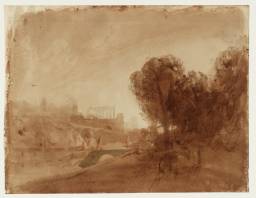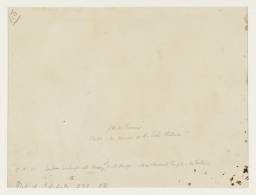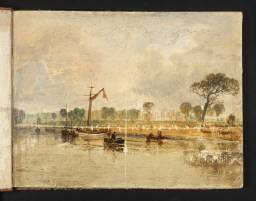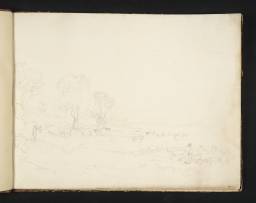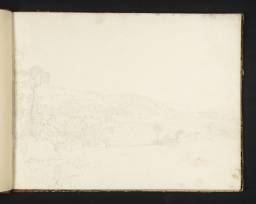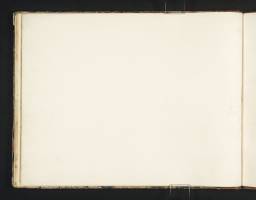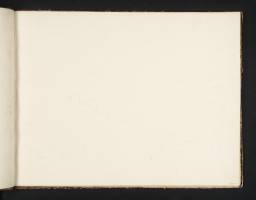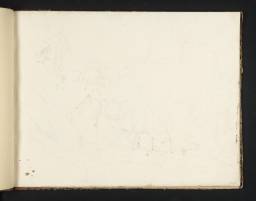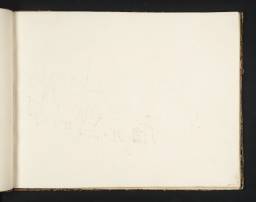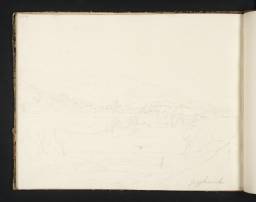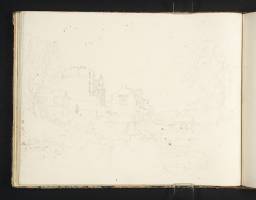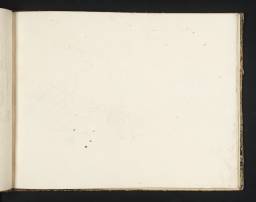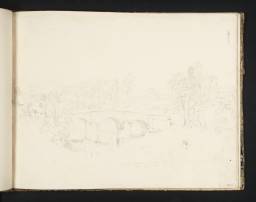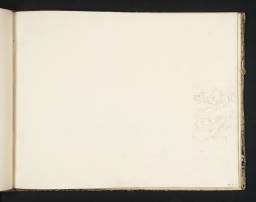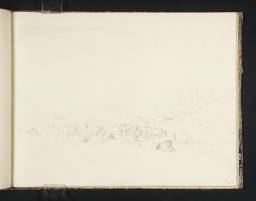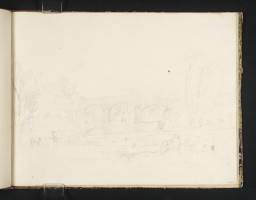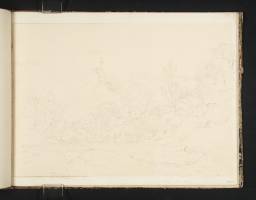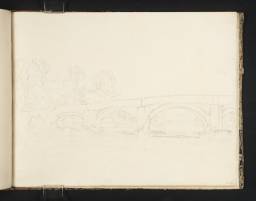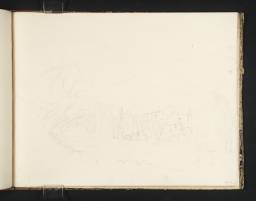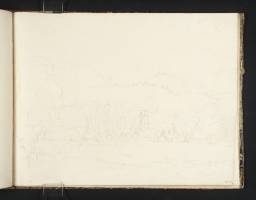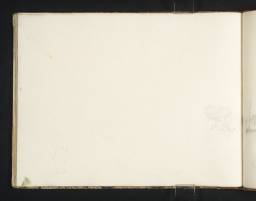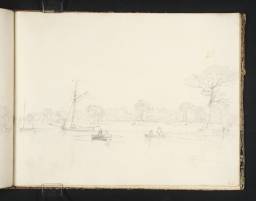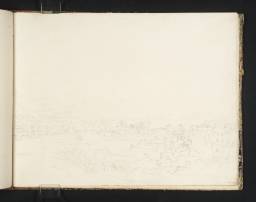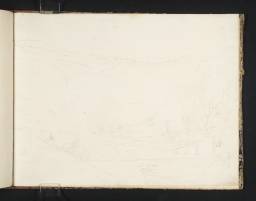Turner Bequest CIII
Sketchbook, bound in boards, with blue and red marbled paper covers and calf spine (repaired)
24 original leaves of off-white wove paper and four leaves of modern cream wove paper
Approximate page size 228 x 295 mm
Made by William Balston and Finch and Thomas Robert Hollingworth at Turkey Mill, Maidstone, Kent
Watermarked ‘J WHATMAN | 1801’
Endorsed by the Executors of the Turner Bequest in ink ‘No 272 | 25 leaves | one in colours. Bistre’ and signed in pencil by John Prescott Knight and Charles Lock Eastlake ‘JPK’ and ‘C.L.E.’ inside back cover (D40721)
24 original leaves of off-white wove paper and four leaves of modern cream wove paper
Approximate page size 228 x 295 mm
Made by William Balston and Finch and Thomas Robert Hollingworth at Turkey Mill, Maidstone, Kent
Watermarked ‘J WHATMAN | 1801’
Endorsed by the Executors of the Turner Bequest in ink ‘No 272 | 25 leaves | one in colours. Bistre’ and signed in pencil by John Prescott Knight and Charles Lock Eastlake ‘JPK’ and ‘C.L.E.’ inside back cover (D40721)
Accepted by the nation as part of the Turner Bequest 1856
Exhibition history
References
This sketchbook (dismantled and later rebound) was used in the summer of 1808 during visits to Tabley House, near Knutsford, Cheshire to paint it for the owner, Sir John Leicester, on an excursion into North Wales and in Lancashire and Yorkshire, in the Ribble Valley and the Craven Dales. Besides drawings and an oil sketch of Tabley there are views of Valle Crucis Abbey in Denbighshire, Giggleswick, Ingleborough and Whalley in Lancashire and Malham Cove in the West Riding of Yorkshire, products of a northern extension of this summer tour that also included Turner’s first visit to Farnley Hall, Wharfedale, to stay with Walter Fawkes. Three pictures and a watercolour are based on subjects in this book, which also contains a composition study and a list of possible historical subjects for the Liber Studiorum.
Tabley No.1 is the largest of three sketchbooks named after the house. The others are Tabley No.2 and Tabley No.3 (Tate D06858–D06983; D40805; Turner Bequest CIV and Tate D06984–D07126; D07128–D07131; D40628–D40630; D40638; Turner Bequest CV). Most of the drawings are in pencil and vary from careful studies to quick outlines; not all the subjects are identifiable, partly because of their lack of detail but also because of the range of territory covered by the book. One Tabley subject is in oil, mixed or varnished with gum arabic, a view in Wales or Lancashire, in watercolour, is similarly varnished and the Liber-related study is in sepia wash. Recipes involving gum arabic are written in the Tabley No.3 sketchbook (D06995: Turner Bequest CV 10a).
Sir John Leicester had emerged since about 1805 as a prominent collector of modern British art. He built a picture gallery at his London house in Hill Street, Mayfair and added another to his country seat, Tabley House, near Knutsford, Cheshire. Turner was already a star of his collection, represented by pivotal works like The Shipwreck (Tate N00476)1 which he bought in 1806 and The Falls of the Rhine at Schaffhausen (Museum of Fine Arts, Boston, Massachusetts)2 which he took in exchange for the former picture the following year. In January 1808 he paid for A Country Blacksmith Disputing upon the Price of Iron (Tate N00478)3 and on 8 May The Examiner reported his purchase of Pope’s Villa at Twickenham, during its Dilapidation (on the London art market in 2008)4 from Turner’s Gallery. Reviewing Turner’s exhibition in June, the Review of Publications of Art praised Sir John who ‘by adding this picture to his collection ... has added much to his former reputation as a tasteful collector of modern art’. His collections in London and Tabley, his taste and his ambitions to found a national gallery of British art have been widely discussed.5
Turner’s pair of pictures of Tabley was to depict the house (built in 1761 by John Carr of York to replace an earlier one in a different position which was then abandoned) across the lower mere or Moat, in contrasting weather conditions. This sketchbook contains drawings (D06845–D06846; Turner Bequest 15a–16) and an oil sketch (D06848; Turner Bequest CIII 18) for Tabley, Cheshire, the Seat of Sir J.F. Leicester, Bart: Calm Morning (Tate T03878; displayed at Petworth House),6 exhibited at the Royal Academy in 1809. Material related to the companion Tabley, the Seat of Sir J.F. Leicester, Bart.: Windy Day (Tabley House Collection, University of Manchester)7 is in the Tabley No.3 sketchbook (Tate D06990, D07002; Turner Bequest CV 7, 17). Tabley had been painted by artists including Richard Wilson and Arthur Devis who favoured views across the water but in Turner’s case the viewpoint reflected where he spent much of his time. The painter Henry Thomson, also staying at Tabley, reported that Turner was usually to be found ‘fishing rather than painting’,8 although Finberg was surely right to point out that Turner got up early to work before other guests were awake. As the oil sketch, presumably made for Sir John’s approval, was taken out of the book and folded for despatch in the post, Evelyn Joll concluded that the ‘calm’ at least was hardly started while Turner was at Tabley. Another possibility, that Sir John was away during part of Turner’s stay, is suggested by Eric Shanes.9
Neither the pencil drawings nor the oil sketch in this sketchbook include the water tower that Sir John had built in the lake. The omission is clearly deliberate and Turner may have thought the structure unpicturesque. Instead, he focused for middle-distance interest on a fisherman in a rowing boat and one or two of the ‘pleasure vessels’ that Sir John kept for ‘aquatic parties’.10 Presumably after seeing the oil sketch, Sir John instructed Turner to include the tower in both pictures and it is present in the drawings in Tabley No.3.That it was a subject of debate for artists is evident from remarks by James Ward, who painted the lake and tower in 1814 (Tate N00385). Paying tribute to Turner’s pictures, Ward told his patron that he ‘had to tell a story that has been told before so beautifully as to make me tremble’ but nevertheless with ‘great Poetic liberties as to the Picturesque’.11 Ward added: ‘I see Tabley Tower as anything but a Picturesque or Rustic object. Accordingly I reasoned thus, The Tower is the subject – its forms are classically simple and elegant’. It is ironic, therefore, that unbeknown to Ward, Turner had at first left the tower out of his drawings. Thomson also painted the lake and tower. While their owner continued to commission competing views by his stable of artists, Turner’s were a triumph with critics and other collectors for their brilliant lighting and varied atmospheric effects. While they were Turner’s first country-house portraits in oil, they escaped the limitations of the genre, incorporating marine elements as Selby Whittingham has observed. Within a year Turner had won a crop of similar commissions from the Earls of Egremont and Lonsdale;12 Petworth and its lake enabled the artist to reprise effects from his calm view of Tabley, which Egremont was to buy in 1827.
It has sometimes been suggested that Sir John Leicester was recommended to Turner by Richard Colt Hoare of Stourhead,13 while Kenneth Woodbridge implies if not the reverse, then a greater influence by Sir John over the other’s collecting habits.14 The two men were close friends since they shared a Grand Tour in 1785–6 and belonged to the same extended circle of landed gentlemen who were also collectors and antiquaries. Hoare owned (or co-owned with Sir John) a villa, Fach-Ddeilliog, by Llyn Tegid near Bala where he stayed every summer, before continuing to Tabley in time for Knutsford Races at the end of July. In 1808, he was at Bala for two weeks until 4 August, and again 16–25 August; he was at Tabley on 7 September, and then went on to visit Thomas Lister Parker at Browsholme Hall in the Forest of Bowland.15 Turner’s established connections with all these patrons and Leicester’s and Parker’s with Walter Fawkes with whom Turner went on to stay at Farnley makes it likely that his trips into Wales and then north coincided with their rounds of visits; at the very least, the dates of Hoare’s travels are a good indication of the time Turner took for his own. Whittingham has suggested an expedition to Bala for more fishing and this would have been a logical conclusion to the tour of the River Dee, through Llangollen and Corwen, recorded in his sketchbooks. This book has drawings of Valle Crucis Abbey near Llangollen (D06843, D06842; Turner Bequest CII 14, 13). Views of Corwen are in Tabley No.2 (for example D06930, D06914, D06916, D06917; Turner Bequest CIV 28a, 44a, 45a, 46a) and prompted a picture, Trout Fishing in the Dee, Corwen Bridge and Cottage (Taft Museum, Cincinnati, Ohio).16 This, and/or another, River Scene with Cattle (Tate N01857) derived from composition studies in the same book (D06920; Turner Bequest CIV 47a), may have been begun at Tabley and the latter picture was left behind there for at least a year. The likeliest conclusion, again proposed by Whittingham,17 would be that Turner returned to Tabley after his Welsh excursion, and did some painting, before setting off northwards.
Turner’s friend Augustus Callcott exhibited A Mill near Llangollen, from a Sketch by Sir Richard Colt Hoare Bart. at the Royal Academy in 1808, and also painted a companion Mill near Corwen about the same time (The National Trust, Hoare Collection, Stourhead).18 Hoare may have hoped for a similar picture from Turner. After touring the Dee, it seems likely that Turner hitched a lift north with Hoare, and the present author has already suggested that he visited Browsholme on his way to Farnley. Leicester may have accompanied them part of the way to take advantage of the fishing rights he owned on the Ribble at Ribchester – an additional attraction for Turner. A little further east on the River Calder, Turner visited Whalley where he drew the bridge and abbey. From this sketchbook, Turner chose D06837; Turner Bequest CIII 8 as the basis for Whalley Bridge and Abbey, Lancashire: Dyers Washing and Drying Cloth (private collection)19 exhibited at the Royal Academy in 1811.
The possibility that this picture was commissioned by Parker of Browsholme has been raised by the present author20 on several grounds including the proximity of the subject, its appeal to his antiquarian and architectural interests having advised Dr Thomas Dunham Whitaker on his History of Whalley (1800–1) with illustrations after Turner, and the circumstantial evidence of its ownership by John Newington Hughes along with another picture by Turner from Parker’s collection;21 the arguments are summarised by Butlin and Joll. Whitaker’s latest antiquarian book, a History of Craven, had appeared in 1805 and although it included no illustrations after Turner, the artist did contribute an earlier drawing of Fountains Abbey for the second (1812) edition and may have considered making new ones. Whalley was the springboard for his tour of the Craven Dales in 1808 and the similarity of subjects and viewpoints in later watercolours of Malham Cove, Bolton Abbey and Barden Tower, bought by Fawkes, to those in Samuel Alken’s aquatints to the 1805 edition of Craven has been noted.22 The drawing of Malham Cove in this sketchbook (D06839; Turner Bequest CIII 10) served as the basis of a watercolour (British Museum, London),23 perhaps made for Fawkes around the same time as other Yorkshire subjects, up to circa 1810.
The other (and later) watercolour to have been developed from this sketchbook is Valle Crucis Abbey, Denbighshire of circa 1825 (Manchester Art Gallery).24 Made for Turner’s series Picturesque Views in England and Wales it is based on folio 23 (D06842; Turner Bequest CIII 13). Also of interest is a sepia-washed composition study (D06851; Turner Bequest CIII 21). Although the scenery is unidentified and there are no figures, the style and treatment resembles studies for the Liber Studiorum and a list of historical subjects inside the back cover (D40065) is also connected with the project, naming both pictures reproduced in it and several others which may have been under consideration for it.
Douglas Hall, ‘The Tabley House Papers’, The Walpole Society, vol.38, 1960–2, pp.59–122; Whittingham 1986; Peter Cannon-Brookes ed., Paintings from Tabley: An Exhibition of Paintings from Tabley House, exhibition catalogue, Heim Gallery, London 1989.
Reported by Joseph Farington via Thomson and Augustus Wall Callcott, 11 February 1809; Charles Sebag-Montefiore in Oxford Companion, p.165.
William Carey, Some Memoirs of the Patronage and Progress of the Fine Arts, in England and Ireland During the Reigns of George the Second, George the Third, and His Present Majesty; with Anecdotes of Lord de Tabley, and Other Patrons, and of Eminent Artists, and Occasional References to British Works of Art, London 1826, p.22.
See Sketchbooks Connected with Work in Sussex, Yorkshire and Cumbria for the Earls of Egremont and Lonsdale 1809.
Kenneth Woodbridge, Landscape and Antiquity: Aspects of English Culture at Stourhead, Oxford 1970, p.243.
M.W. Thompson ed., The Journeys of Sir Richard Colt Hoare through Wales and England 1793–1810, 1983, p.62; Whittingham 1986, pp.31, 34 note 76.
David Blayney Brown, Augustus Wall Callcott, exhibition catalogue, Tate Gallery, London 1981, pp.68, 69 reproduced.
Technical Notes
How to cite
David Blayney Brown, ‘Tabley No.1 sketchbook 1808’, sketchbook, May 2010, in David Blayney Brown (ed.), J.M.W. Turner: Sketchbooks, Drawings and Watercolours, Tate Research Publication, December 2012, https://www

